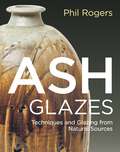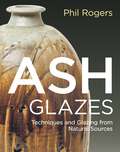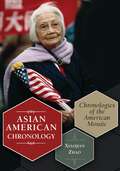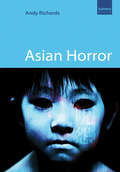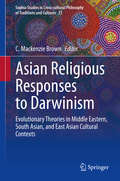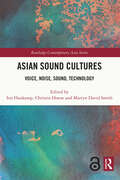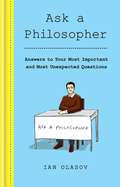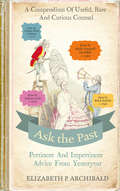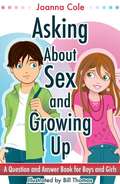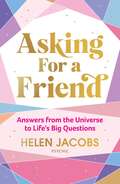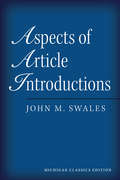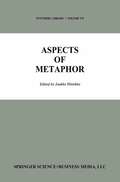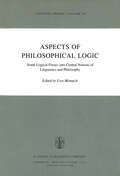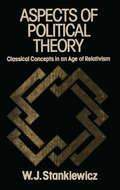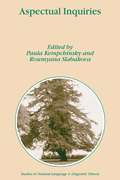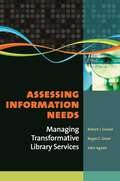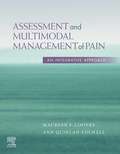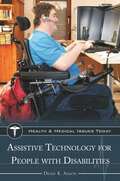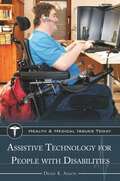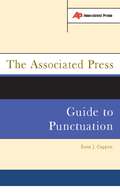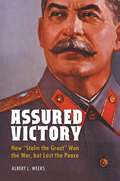- Table View
- List View
Ash Glazes: Techniques and Glazing from Natural Sources
by Phil RogersFully updated and revised, with new photographs and glaze recipes, this is the third edition of this classic guide to ash glazes.Forever curious and eager to learn new things about ceramics, Phil Rogers constantly tinkered with clay bodies, glaze formulae and approaches to firing. This volume is his seminal work on transforming ash into glaze: an essential text for all potters and ceramicists with additional relevance today with its focus on prioritising the use of natural resources.Ash Glazes examines the practicalities of collecting and testing wood ashes, demonstrates the process of making them into glazes and offers a step-by-step guide to using them to decorate your pots.This edition, updated and revised by Hajeong Lee Rogers, is a celebration of pottery at its best. Starting with an introduction to the history of ash glazes, then moving on to a wide range of practical advice and methods, the book is enlivened by photographs of the work of potters from around the world, who use ash in colourful and imaginative ways. It provides true inspiration for working potters and delight for all those interested in contemporary ceramics.
Ash Glazes: Techniques and Glazing from Natural Sources
by Phil RogersFully updated and revised, with new photographs and glaze recipes, this is the third edition of this classic guide to ash glazes.Forever curious and eager to learn new things about ceramics, Phil Rogers constantly tinkered with clay bodies, glaze formulae and approaches to firing. This volume is his seminal work on transforming ash into glaze: an essential text for all potters and ceramicists with additional relevance today with its focus on prioritising the use of natural resources.Ash Glazes examines the practicalities of collecting and testing wood ashes, demonstrates the process of making them into glazes and offers a step-by-step guide to using them to decorate your pots.This edition, updated and revised by Hajeong Lee Rogers, is a celebration of pottery at its best. Starting with an introduction to the history of ash glazes, then moving on to a wide range of practical advice and methods, the book is enlivened by photographs of the work of potters from around the world, who use ash in colourful and imaginative ways. It provides true inspiration for working potters and delight for all those interested in contemporary ceramics.
Asian American Chronology: Chronologies of the American Mosaic (Non-ser.)
by Xiaojian ZhaoKey moments in Asian American history come alive in this concise and accessible chronology.Understanding the history of Asians in America is key to understanding the development of America itself. Asian American Chronology: Chronologies of the American Mosaic presents the most influential events in Asian American history—as well as key moments that have remained under the historical radar. This in-depth record covers events from the 18th century to the present day, including the 2008 Olympic Games in Beijing. Entries, organized chronologically by category, allow readers to trace the development of Asian peoples and culture in the United States over time, including the role of Chinese labor in building railroads, the importation of Filipino slaves, labor strikes and civil rights issues, Japanese-American internment, women's roles, literature, music, politics, and increased immigration in the mid-20th century. In addition to these broad topics, the book also treats individual events from the Rock Springs Massacre to the Gold Rush to the current prevalence of Japanese players in Major League Baseball.
Asian Horror
by Andy RichardsSince Japanese horror sensations The Ring and Audition first terrified Western audiences at the turn of the millenium, there's been a growing appreciation of Asia as the hotbed of the world's best horror movies. Over the last decade Japan, South Korea, Thailand and Hong Kong have all produced a steady stream of stylish supernatural thrillers and psychological chillers that have set new benchmarks for cinematic scares. Hollywood soon followed suit, producing high-profile remakes of films like The Ring, Dark Water, The Grudge and The Eye. With scores of Asian horror titles now available to Western audiences, this Kamera Books edition helps the viewer navigate the eclectic mix of vengeful spooks, yakuza zombies, feuding warlocks and devilish dumplings on offer, discussing the grand themes of Asian horror cinema and the distinctive national histories that give the films their special resonance. Tracing the long and noble tradition of horror stories in eastern cultures, it also delves into some of the folk-tales that have influenced this latest wave of shockers, paying tribute to classic Asian ghost films throughout the ages.
Asian Religious Responses to Darwinism: Evolutionary Theories in Middle Eastern, South Asian, and East Asian Cultural Contexts (Sophia Studies in Cross-cultural Philosophy of Traditions and Cultures #33)
by C. Mackenzie BrownThis volume brings together diverse Asian religious perspectives to address critical issues in the encounter between tradition and modern western evolutionary thought. Such thought encompasses the biological theories of Charles Darwin, Jean-Baptiste Lamarck, Earnest Haeckel, Thomas Huxley, and later “neo-Darwinians,” as well as the more sociological evolutionary theories of thinkers such as Herbert Spencer, Pyotr Kropotkin, and Henri Bergson. The essays in this volume cover responses from Hindu, Jain, Buddhist (Chinese, Japanese, and Indo-Tibetan), Confucian, Daoist, and Muslim traditions. These responses come from the decades immediately after publication of The Origin of Species up to the present, with attention being paid to earlier perspectives and teachings within a tradition that have affected responses to Darwinism and western evolutionary thought in general. The book focuses on three critical issues: the struggle for survival and the moral implications read into it; genetic variation and its seeming randomness as related to the problems of meaning and purpose; and the nature of humankind and human exceptionalism. Each essay deals with one or more of the three issues within the context of a specific tradition.
Asian Sound Cultures: Voice, Noise, Sound, Technology (Routledge Contemporary Asia Series)
by Iris Haukamp Christin Hoene Martyn David SmithThis book examines the meanings, uses, and agency of voice, noise, sound, and sound technologies across Asia. Including a series of wide-ranging and interdisciplinary case studies, the book reveals sound as central to the experience of modernity in Asia and as essential to the understanding of the historical processes of cultural, social, political, and economic transformation throughout the long twentieth century. Presenting a broad range of topics – from the changing sounds of the Kyoto kimono making industry to radio in late colonial India – the book explores how the study of Asian sound cultures offers greater insight into historical accounts of local and global transformation. Challenging us to rethink and reassemble important categories in sound studies, this book will be a vital resource for students and scholars of sound studies, Asian studies, history, postcolonial studies, and media studies.
Asian Sound Cultures: Voice, Noise, Sound, Technology (Routledge Contemporary Asia Series)
by Iris Haukamp Christin Hoene Martyn David SmithThis book examines the meanings, uses, and agency of voice, noise, sound, and sound technologies across Asia. Including a series of wide-ranging and interdisciplinary case studies, the book reveals sound as central to the experience of modernity in Asia and as essential to the understanding of the historical processes of cultural, social, political, and economic transformation throughout the long twentieth century. Presenting a broad range of topics – from the changing sounds of the Kyoto kimono making industry to radio in late colonial India – the book explores how the study of Asian sound cultures offers greater insight into historical accounts of local and global transformation. Challenging us to rethink and reassemble important categories in sound studies, this book will be a vital resource for students and scholars of sound studies, Asian studies, history, postcolonial studies, and media studies.
Ask a Philosopher: Answers to Your Most Important – and Most Unexpected – Questions
by Ian OlasovThe perfect gift for the smart thinker in your life.For several years Ian Olasov has set up 'Ask-a-Philosopher' booths around New York City, answering questions from passersby. Now in this book he offers answers to the real-life questions on people's minds.From the philosophical to the frivolous, questions include:- Are people innately good or bad?- Is it okay to have a pet fish?- Is it okay to have kids?- Is colour subjective?- If humans colonise Mars, who will own the land?- Is ketchup a smoothie?- Is there life after death?- Should I give money to homeless people?Every question is approached from a philosophical standpoint, but the answer is made fun and accessible for everyone. One of the many joys of this book is that you see how philosophy can be both perfectly continuous with everyday life and also utterly transporting.
Ask the Past: Pertinent and Impertinent Advice from Yesteryear
by Elizabeth ArchibaldWant to know how to garden with lobsters? How to sober up? Grow a beard? Or, simply, how to make a perfect cheesy omelette? Look no further than Ask the Past. Chock-full of advice that has (and some that hasn't!) stood the test of time, Ask the Past is the tongue-in-cheek compilation of hilarious and true answers to life's questions, drawn from actual antique sourcebooks by a historian and bibliophile.From medieval headache remedies to Renaissance pick-up lines, Ask the Past brings you advice that will make you laugh out loud and shake your head in amazement. Here are the answers to the questions you’ve always wanted to ask – 'How do I impress my boss?' or 'How do I put out a fire' – and some that you didn’t know you needed to. Brimming with advice both wise and weird, and illustrated throughout with charming images from rare books, Ask the Past offers a surprising vision of the past, together with a hilarious menu of solutions to the knotty problems of the present – like how to kill a snake with a radish!
Asking About Sex And Growing Up: A Question And Answer Book For Kids (PDF)
by Joanna Cole Bill ThomasWhat do you want to know about sex? Information about sex is everywhere. But what you learn from TV, movies, the internet, and friends is not always a healthy or accurate view of sexuality. Now revised and updated with current facts, Joanna Cole's Asking About Sex & Growing Up is the perfect book to provide answers to questions about sex. Writing especially for preteens, the author uses a question-and-answer format to offer straightforward information on a wide variety of subjects related to sex and puberty.
Asking for a Friend: Three Centuries of Advice on Life, Love, Money, and Other Burning Questions from a Nation Obsessed
by Jessica WeisbergA delightful history of Americans' obsession with advice -- from Poor Richard to Dr. Spock to Miss Manners Americans, for all our talk of pulling ourselves up by our bootstraps, obsessively seek advice on matters large and small. Perhaps precisely because we believe in bettering ourselves and our circumstances in life, we ask for guidance constantly. And this has been true since our nation's earliest days: from the colonial era on, there have always been people eager to step up and offer advice, some of it lousy, some of it thoughtful, but all of it read and debated by generations of Americans. Jessica Weisberg takes readers on a tour of the advice-givers who have made their names, and sometimes their fortunes, by telling Americans what to do. You probably don't want to follow all the advice they proffered. Eating graham crackers will not make you a better person, and wearing blue to work won't guarantee a promotion. But for all that has changed in American life, it's a comfort to know that our hang-ups, fears, and hopes have not. We've always loved seeking advice -- so long as it's anonymous, and as long as it's clear that we're not asking for ourselves; we're just asking for a friend.
Aspects of Article Introductions, Michigan Classics Ed. (Michigan classics edition #no. 1)
by John M. SwalesAspects of Article Introductions has bee reissued to make it more easily available than it has ever been, particularly for the use of university libraries and for younger and newer practitioners and researchers in the rapidly expanding and increasingly global field of EAP. The original Aspects of Article Introductions appeared in fall 1981 as a ring-bound 90-page monograph. The “publisher” was the Language Studies Unit at the University of Aston in Birmingham. Although essentially an “underground” work, it has remained a relevant part of the short intellectual history of English for Academic Purposes, particularly as genre-based or genre-driven approaches to EAP research and pedagogical practice have become more popular. Its longevity is also a testament to the genre analysis work of John Swales, but in addition, the research article has become the most influential genre in most areas of scholarship, and introductions are at least supposed to be read first and to be designed in such a way as to attract as large readership as possible. “If I were asked to list the most influential texts in applied linguistics over the last 30 years, John Swales' Aspects of Article Introductions would be in the top three or four. This was a seminal work which not only presented a novel way of analysing texts and a commentary on academic discourse, but one which helped to establish a foundation for the massive interest we see today in describing the structure and features of academic articles. This is not just a text which offers us a glimpse of an intellectual history, but it remains full of fascinating insights and observations about texts and the workings of academic discourse. While the ideas may have evolved and the genre it describes moved on, both the style of writing and the methodology it describes are as fresh and as revealing as anything written on the topic since.” ---Ken Hyland, Hong Kong University
Aspects of Philosophical Logic: Some Logical Forays into Central Notions of Linguistics and Philosophy (Synthese Library #147)
by Uwe MönnichThis volume constitutes the Proceedings of a workshop on formal seman tics of natural languages which was held in Tiibingen from the 1st to the 3rd of December 1977. Its main body consists of revised versions of most of the papers presented on that occasion. Three supplementary papers (those by Gabbay and Sma by) are included because they seem to be of particular interest in their respective fields. The area covered by the work of scholars engaged in philosophical logic and the formal analysis of natural languages testifies to the live liness in those disciplines. It would have been impossible to aim at a complete documentation of relevant research within the limits imposed by a short conference whereas concentration on a single topic would have conveyed the false impression of uniformity foreign to a young and active field. It is hoped that the essays collected in this volume strike a reasonable balance between the two extremes. The topics discussed here certainly belong to the most important ones enjoying the attention of linguists and philosophers alike: the analysis of tense in formal and natural languages (van Benthem, Gabbay), the quickly expanding domain of generalized quantifiers (Goldblatt), the problem of vagueness (Kamp), the connected areas of pronominal reference (Smaby) and presupposition (von Stechow) and, last but not least, modal logic as a sort of all-embracing theoretical framework (Bressan). The workshop which led to this collection formed part of the activities celebrating the 500th anniversary of Tiibingen University.
Aspects of Political Theory: Classical Concepts in an Age of Relativism
by W J StankiewiczFirst published in 1976. This study continues an endeavour whose aim was to use traditional concepts as a basis for the discussion of contemporary political predicaments. The endeavour began with the publication of the symposium In Defense of Sovereignty (1969). Its long-range goal is to consider under a common denominator—relativism in politics— various aspects of theory such as the basic concepts discussed in the present essay, together with more modern theories of democracy and the wider spectrum of political ideologies.
Aspects of Political Theory: Classical Concepts in an Age of Relativism
by W. J. StankiewiczFirst published in 1976. This study continues an endeavour whose aim was to use traditional concepts as a basis for the discussion of contemporary political predicaments. The endeavour began with the publication of the symposium In Defense of Sovereignty (1969). Its long-range goal is to consider under a common denominator—relativism in politics— various aspects of theory such as the basic concepts discussed in the present essay, together with more modern theories of democracy and the wider spectrum of political ideologies.
Aspectual Inquiries (Studies in Natural Language and Linguistic Theory #62)
by Roumyana Slabakova Paula KempchinskyThe study of the linguistic reflexes of aspect has been an active field of research in various sub-disciplines of linguistics, such as syntax, semantics (including discourse theory) and acquisition studies. However, communication and dissemination of results across these various subfields has often been indirect. The different angles brought together give us a comprehensive picture of the representation of aspect in the mind/brain of the speaker. The papers in this volume represent the results of a workshop on the syntax, semantics and acquisition of aspect held in 2002 whose purpose was to foment active cross-disciplinary communication. A number of the papers examine the syntactic representation of lexical or situation aspect, while others focus on the syntactic interaction of lexical aspect with grammatical aspect, and of grammatical aspect and tense. Other papers examine the role of aspect in discourse representations, while a third group of papers reports on results of empirical studies on the acquisition of aspect in both first and second language acquisition, and patterns of loss of morphosyntactic reflexes of aspect in language attrition.
Assessing Information Needs: Managing Transformative Library Services
by Robert J. Emeritus Roger C. Greer John AgadaBased on a tested model for community analysis, this book offers a guide to the management of client-centered transformative information services that can be applied in any type of library or information agency.Knowing a community enables library and information professionals to prioritize the community's information needs and design appropriate services for them. Assessing Information Needs: Managing Transformative Library Services was written to provide the rationale for community analysis, a model for gathering community data, and a process for analyzing data and applying it to the management of an information agency. The book explains why information professionals should customize services, as well as the "how to" of collecting data. A model for gathering community information is described, applied, and demonstrated through a case study. The book then shows how such information is interpreted and used to plan information services that are transformative for individuals and groups in the case-study community, providing lessons that readers can use with their own institutions. Rooted in a philosophy of customer service, the method presented here is perfect for public, school, academic, and special libraries or other types of information agencies.
Assessment and Multimodal Management of Pain - E-Book: An Integrative Approach
by Maureen Cooney Ann Quinlan-ColwellLearn best practices and evidence-based guidelines for assessing and managing pain! Assessment and Multimodal Management of Pain: An Integrative Approach describes how to provide effective management of pain through the use of multiple medications and techniques, including both pharmacologic and non-pharmacologic treatment regimens. A holistic approach provides an in-depth understanding of pain and includes practical assessment tools along with coverage of opioid and non-opioid analgesics, interventional and herbal approaches to pain, and much more. Written by experts Maureen F. Cooney and Ann Quinlan-Colwell, this reference is a complete, step-by-step guide to contemporary pain assessment and management.Evidence-based, practical guidance helps students learn to plan and implement pain management, and aligns with current guidelines and best practices.Comprehensive information on the pharmacologic management of pain includes nonopioid analgesics, opioid analgesics, and co-analgesics, including dose titration, routes of administration, and prevention of side effects.UNIQUE! Multimodal approach for pain management is explored throughout the book, as it affects assessment, the physiologic experience, and the culturally determined expression, acknowledgement, and management of pain.UNIQUE! Holistic, integrative approach includes thorough coverage of pain management with non-pharmacologic methods.Clinical scenarios are cited to illustrate key points.Equivalent analgesic action for common pain medications provides readers with useful guidance relating to medication selection. Pain-rating scales in over 20 languages are included in the appendix for improved patient/clinician communication and accurate pain assessment.UNIQUE! Authors Maureen F. Cooney and Ann Quinlan-Colwell are two of the foremost authorities in multimodal pain assessment and management.Sample forms, guidelines, protocols, and other hands-on tools are included, and may be reproduced for use in the classroom or clinical setting.
Assistive Technology for People with Disabilities (Health and Medical Issues Today)
by Denis K. AnsonHow would you make a phone call or send email if you couldn't hear, see, or use your hands? This book shows how assistive technology helps individuals with disabilities perform tasks that people without disabilities may take for granted.Assistive technology can be used in two ways: to help people with disabilities to do things that people without disabilities can do without technology, and to improve access to everyday technology that is not designed for people with disabilities. In both cases, the focus is on matching individuals with the tools best suited to fill their needs. A part of Greenwood's Health and Medical Issues Today series, Assistive Technology for People with Disabilities explores what technologies are available to individuals with disabilities, what they can help them to accomplish, and potential hurdles to their use that must be overcome. It explores this exciting field broadly and in depth while still keeping the "people-first" mindset that is the hallmark of assistive technology. In addition, it provides guidance and resources for individuals seeking assistive technology for themselves or for a loved one.
Assistive Technology for People with Disabilities (Health and Medical Issues Today)
by Denis K. AnsonHow would you make a phone call or send email if you couldn't hear, see, or use your hands? This book shows how assistive technology helps individuals with disabilities perform tasks that people without disabilities may take for granted.Assistive technology can be used in two ways: to help people with disabilities to do things that people without disabilities can do without technology, and to improve access to everyday technology that is not designed for people with disabilities. In both cases, the focus is on matching individuals with the tools best suited to fill their needs. A part of Greenwood's Health and Medical Issues Today series, Assistive Technology for People with Disabilities explores what technologies are available to individuals with disabilities, what they can help them to accomplish, and potential hurdles to their use that must be overcome. It explores this exciting field broadly and in depth while still keeping the "people-first" mindset that is the hallmark of assistive technology. In addition, it provides guidance and resources for individuals seeking assistive technology for themselves or for a loved one.
Assistive Technology for Persons with Print Disabilities - WBM (World Bank Modules)
by BookshareThis comprehensive guide explores a multitude of assistive technologies tailored for individuals with print disabilities, specifically focusing on the blind and low-vision community. It covers diverse solutions, including traditional Braille methods, modern refreshable Braille displays, audio books enhanced by DAISY standards, specialized Braille note takers, online libraries like Bookshare and Audible, and reading machines utilizing OCR and TTS engines. Additionally, it delves into handheld magnification devices aiding both reading and distance viewing, advancements in tactile learning materials for graphics and maps, as well as innovations in accessible maps for navigation. Addressing challenges faced by those with low vision, the guide highlights reading aids with text-to-speech features and various magnification devices. It also emphasizes the significance of mobility aids like the Ultrasonic Smart cane and the transformative role of smartphones—especially Android for enhancing independence, offering reading capabilities, navigation, social connectivity, and more, making a significant impact on the lives of individuals with disabilities.
The Associated Press Guide To Punctuation
by Rene J. CapponIn the no-nonsense, authoritative tradition of the best-selling AP Stylebook, the top editors at the AP have written the definitive guide to punctuation. More people write for the Associated Press than for any other news service, and more writers take their style and word-usage cues from this world-famous institution than from any other journalism source. From the when and how of the ampersand to the rules for dashes, slashes, and brackets; from the correct moment for the overused exclamation point to the rules of engagement for the semicolon, The AP Guide to Punctuation is an invaluable and easy-to-use guide to the most important aspect of clear and persuasive writing.
Assured Victory: How "Stalin the Great" Won the War, but Lost the Peace
by Albert L. WeeksThis book documents dictator Joseph Stalin's brilliant tactics as well as missteps in taking preemptive actions that guaranteed ultimate victory over the German invaders. It also covers the policies implemented after the war that made the Soviet Union a menace to world peace and led to collapse of Soviet rule.A detailed reexamination of historical facts indicates that Stalin could deserve to be regarded as a "great leader." Yet Stalin clearly failed as his nation's leader in a post-World War II milieu, where he delivered the Cold War instead of rapid progress and global cooperation. It is the proof of both Stalin's brilliance and blunders that makes him such a fascinating figure in modern history.Today, most of the Russian population acknowledges that Stalin achieved "greatness." The Soviet dictator's honored place in history is largely due to Stalin successfully attending to the Soviet Union's defense needs in the 1930s and 1940s, and leading the USSR to victory in the war on the Eastern Front against Nazi Germany and its allies. This book provides an overdue critical investigation of how the Soviet leader's domestic and foreign policies actually helped produce this victory, and above all, how Stalin's timely support of a wartime alliance with the Western capitalist democracies assured the defeat of the Axis powers in 1945.
